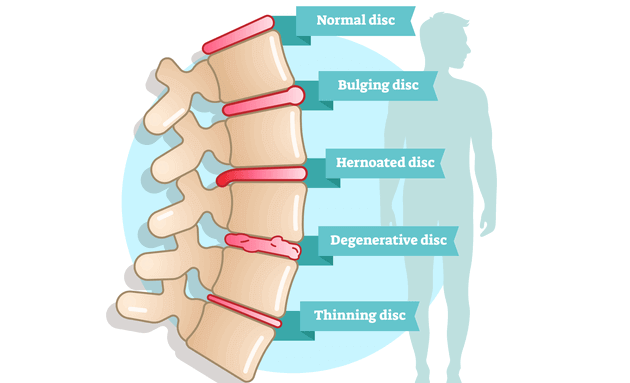
Suffering From Back Pain? Here’s What It Could Mean
A recent study published by The Lancet states that lower back pain affects more than 540 million people worldwide. It is the 4th leading cause of disability among Indians.
Are You Ignoring These Warning Signs of Lower Back Pain?

Amitabh Bacchan suffered from Spinal Tuberculosis, mistaking it for regular lower back pain. Are you missing out on any warning signs of lower back pain?
- Radiating Pain: Your back pain may move down the front, side, or the back of your leg
- Worsening Pain: Your back pain is progressive and gets worse with time
- Nocturnal Pain: Your lower back pain intensifies at night
- Weakness or Numbness: A part of your leg may feel weak or numb
If you’re experiencing any of the above symptoms, visit a healthcare professional at the earliest. He or she will first diagnose the type of back pain you have and then suggest relevant treatment options.
What Type of Back Pain Are You Suffering From?
How you describe your back pain will determine the kind of treatment you will be administered. Based on the location and any related symptoms, the three types of back pain are:
- Axial Pain: The most common type of lower back pain, axial pain is also known as mechanical pain, and will occur only on one part. Symptoms of axial pain include sharp or dull pain that keeps reappearing. Axial back pain is mostly caused by muscle strain.
- Referred Pain: Referred back pain generally moves from one place to another and may vary in intensity. Common symptoms include dull and achy pain. A probable cause of referred back pain is a degenerative disc. Visit your doctor if you experience any discomfort.
- Radicular Pain: Also known as Sciatica or Radiculopathy, radicular pain follows the course of your spinal nerve as it progresses beyond your spinal cord. The pain is commonly described as electric-shock like. It is caused by compression or inflammation of a spinal root, a herniated disc, spinal stenosis, or spondylolisthesis.
What Causes Back Pain?

Our spinal cord is made up of 33 bones, 23 discs and 31 pairs of nerves. With such a complex structure, there can be multiple reasons for your back to hurt.
Unfortunately, 85% of patients with lower back pain have failed to identify the right cause of their back pain. But with the advancement in technology and procedures like Digital Spine Analysis, you can now pinpoint the reason for your lower back pain.
Here are the 5 most common causes of lower back pain:
- Wrong Posture
[caption id="attachment_11947" align="alignnone" width="630"] Back pain due to Wrong posture[/caption]
Back pain due to Wrong posture[/caption]
We spend at least 9 hours sitting at the office every day. Sitting increases pressure on your spine by 200% and can be a cause of experiencing lower back pain. Here are a few ways to keep your back in health at work.
- Deteriorating Muscle Health
The soft muscles in your spine bear almost 70% of your body weight. Factors like lack of physical exercise, overloading, poor posture, lack of nutrition, injury, and genetic factors may contribute to deteriorating muscle health and muscle degeneration. The good news is that 85% of back pain can be treated, as soft muscle tissues can be regenerated at any age with a guided spine rehabilitation program.
- Disc Degeneration

Your disc is made up of 80% water and is a jelly-like structure. Wear and tear to your disc can cause lower back pain. Main causes of disc degeneration are ageing, wear and tear, lack of nutrition, smoking, dehydration, and trauma. If identified on time, some discs can be treated without surgery.
- Injury
Putting a strain on your back, heavy lifting, or repeated trauma or injury, gym injuries, or sports can cause muscle tear and cause back pain. Painkillers are not always the solution - try exercising and correcting your posture, resting your back, and eating well. If problems persist, consult a doctor.
- Constant Pressure On Nerves
Changes in disc pressure, bone structures, or soft tissues can lead to pressure on your spinal nerves which can lead to a painful back. If your back pain is radiating to your arms and legs, consult a spine specialist immediately.
Some Causes Of Back Pain You Didn’t Know About
[caption id="attachment_11949" align="alignnone" width="630"]
 Managing Backpain | Medanta[/caption]
Managing Backpain | Medanta[/caption]
Back pain is a personal, complicated experience and differs for everybody. From causes to symptoms and duration of treatment, your back pain will differ in intensity.
Apart from the wear and tear our spine endures, did you know, there could be other simple things that could cause you back pain?
Let’s look at some of the causes of back pain we tend to overlook or misunderstand:
- Sneezing too hard: A hard sneeze can cause a slipped disc, hernia, or in rare cases, paralysis of limbs. A powerful sneeze can disrupt your spine health by exerting pressure or shock on the disc. If you experience back pain after a sneeze, don’t ignore it.
- Your back pain could be linked to your feet: Our body is like a chain - each bone, joint, and muscles are linked to one another. If your lower back has been hurting, it could be because you changed the way you walked or a change in footwear. The change in your walking pattern affects the whole chain of your lower body from ankle to lower back, thereby causing back pain.
- Malaria can cause back pain: Monsoons and post monsoons are known as the season of infections and diseases. The state of Uttar Pradesh has reported recent cases of Malaria, so if you or someone you know has returned from an endemic area and is suffering from fever, check for Malaria as well. Along with nausea and weakness, Malaria can cause lower back pain too.
- Pneumonia: Pneumonia is an infection in your lungs that can cause back pain along with other symptoms like mucus-filled cough, fever, and vomiting.
- Kidney Stones: A kidney stone can often come across as a pulled or strained muscle around your mid-back and ribcage. If your pain is excruciating and reappears suddenly, it is more than just back pain.
- Endometriosis: Endometriosis is a condition where your uterine lining grows outside your uterus, causing abdominal and lower back pain that intensifies during periods.
Managing Lower Back Pain

Whatever may be the cause of your lower back pain, it can be unnerving. Here are 5 ways you can manage your lower back pain at home. However, if pain persists, consult a healthcare professional at the earliest.
- Ice and Heat: Ice compress is best applied in the first 24-48 hours after an injury as it reduces inflammation. After 48 hours, switch to applying heat if you prefer. Give your skin 20 minutes rest with every compress.
- Keep Moving: Do your regular work, like making the bed, going to work, and going for walks. Once you feel better, try cycling, yoga, or aerobics to keep your back healthy.
- Stretch: Sitting slumped on our desks all day harms our spinal health. Take stretch breaks and try stretching backwards. Give your legs some movement as well.
- Wear low heels: Replace your 4-inch pumps with flats or low heels (less than 1-inch). High heels create unstable posture and increase pressure on your lower spine.
- Improve your posture: Be careful when lifting heavy objects. Don’t bend over from the waist, but bend and straighten from the knees.
Eating Habits That Fight Back Pain

Many foods have been shown to reduce (or increase) inflammation, a known cause for back pain. So when you have back pain, changing your diet may help you avoid it.
A plant-based anti-inflammatory diet can help relieve back pain and keep your back health in shape. Vegetables like carrots, beets, sweet potatoes, cherries, berries, grapes and red wine, pomegranate, and watermelon. Herbs and spices include basil, cinnamon, ginger, rosemary, garlic, curcumin, onions, oregano, and turmeric. Also, drink healthy herbal teas and true teas (green, oolong, and white). Flax and chia seeds, especially when eaten in combination with omega-3-rich coldwater fish like salmon, mackerel, sardines, and tuna can help with back health.
Apart from the above mentioned, try to quit smoking and watch your weight to keep your back health in shape.

